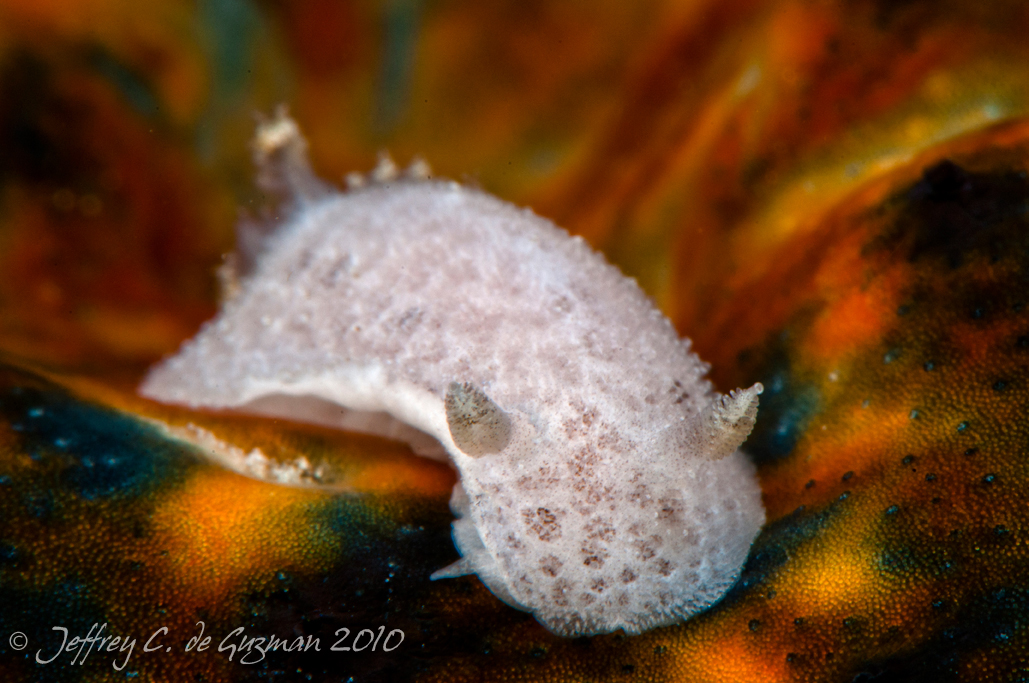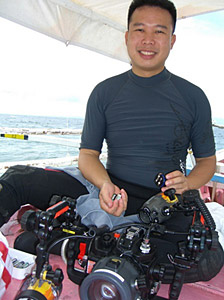 |
Tayuva lilacina
Image courtesy of Jeffrey de GuzmanAnilao, Philippines
Nikon D300, Sea and Sea Housing, Nikkor 105mm VR macro, Twin Inon Z240 strobes
It is a most opportune time to see Jeff de Guzman's great "head on" shot of this common shallow water discodorid. You would think that the taxonomy of this species is fairly straight forward, but you would sadly be mistaken. Hopefully, much of the confusion surrounding the discodorids has now been resolved with the publication of a new monograph by my former postdoc, Benoit Dayrat. Benoit decided to take on this group of "dirty dorids" and ended up dissecting at least 400-500 specimens to more fully understand the range of variation of the species found in this group. The publication: A monographic revision of basal discodorid sea slugs (Mollusca: Gastropoda: Nudibranchia: Doridina), was published earlier this year as a supplement to the Proceedings of the California Academy of Sciences and can be downloaded for free in PDF format.
Traditionally, the name Discodoris has been applied to a whole group of dorids with figure-like oral tentacles and a body that is covered with simple rather than complex bumps on the back. You can see one of the oral tentacles in the lower left corner of Jeff's photo. From Benoit's study, he concludes that only the type species, Discodoris boholensis, and two other species, Discodoris cebuensis and Discodoris sp. 5 in our Indo-Pacific Nudibranchs and Sea Slugs, should be included in Discodoris. The rest of the species need to be included in other dorid groups. The animal in Jeff's photo is now called Tayuva lilacina. This animal has often been confused with another similar looking species that should be called
California Academy of Sciences
San Francisco, CA 94118
Jun., 2010
Jeff Guzman on location
 |
Jeffrey de Guzman is a 39-year old technical diver. He was certified as a NAUI open water diver in 1986. In May 2006, Jeffrey made his first venture into u/w photography with a Canon S80 compact camera. He has since upgraded to a DSLR. Examples of his work have appeared in major publications, such as Australasia Scuba Diver Magazine, Asian Diver Magazine, Popular Photography Magazine, the Padi Project Aware Website, Padi Newsletters, Neville Coleman's Nudibranch Encyclopedia, Indo Pacific Nudibranchs and Sea Slugs, Newsweek, the National Geographic Daily Dozen and three Canon Photo of the Month. Jeffrey was chosen as the Featured Photographer at Scubadivng.com for the month of February 2008, and as the Inon Featured Photographer for July 2008. In 2009, Jeff won 2nd place (Super Macro Traditional) in Our World Underwater. 1st place in Macro Category Scuba Diver Australasia TTL. Jeff hopes to house his new Nikon D3x in the near future. Send Jeff email at jeffdeguzman@gmail.com |

|
